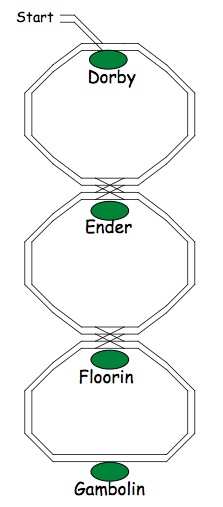Or search by topic
Number and algebra
Geometry and measure
Probability and statistics
Working mathematically
Advanced mathematics
For younger learners
Simple Train Journeys



- Problem
- Getting Started
- Student Solutions
- Teachers' Resources
Simple Train Journeys
Well, here's a train route. The train starts at the top and makes a number of visits to the stations.
Now let's suppose that the train is going to make visits to three stations (they do not have to be different stations - each station can be visited several times!).

Your challenge is to find all the different journeys for visiting four stations.
Can you predict the number of different journeys for visiting seven stations? Were you right?
You might like to then invent your own routes that may go further than this one and then answer similar questions that you can think up.
Initially, this problem could be introduced in a similar way as is suggested in the notes for Train Routes, but it would be good to focus more on looking for patterns and generalising in this case. You might like to work on the different routes for four stations as a whole class then ask small groups to look at
five and six stations so that you can pool results. Ask the children how they are recording the different routes - using initial capitals to stand for the stations is a great help, but share any good ways the pupils have found.
In order to look for a pattern in the numbers of routes, it might be helpful to make a table, something like this:
| Number of station visits | Number of different journeys |
| 3 | 2 |
| 4 | |
| 5 |
You may also like
Counting Counters
Take a counter and surround it by a ring of other counters that MUST touch two others. How many are needed?
Cuisenaire Squares
These squares have been made from Cuisenaire rods. Can you describe the pattern? What would the next square look like?
Doplication
We can arrange dots in a similar way to the 5 on a dice and they usually sit quite well into a rectangular shape. How many altogether in this 3 by 5? What happens for other sizes?

